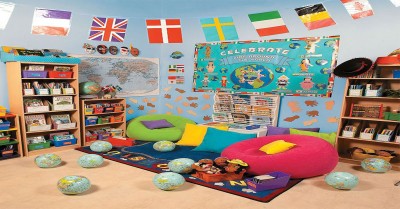Learning environments are spaces that facilitate the all-round development of children through developmentally appropriate routines, program plans, tools as well as opportunities for play and exploration. The indoor environment, playground, outdoors are some common learning environments that should be welcoming and understanding of the needs, backgrounds and abilities of all children.
Here is how you can plan learning environments that show respect for diversity.
- In order to make the families and students of non-English speaking backgrounds feel engaged, post translated notices and other information. Though this is easier to implement indoors like in classrooms and the service, see how they can be done in the playground and on outdoor trips.
- At indoor meetings, public forums or when taking children in the outdoors, acknowledge the traditional custodians of the land.
- In the classroom, ensure that posters, artworks, charts and other wall displays include figures with diverse skin colours, abilities and professions; similarly equip craft and play areas with toys, books, dolls, stickers and puppets from a variety of races and ethnicities.
- Plan lessons with stories, songs, poems and rhymes from different cultures and create positive associations with darker colours by using stories like Black Beauty.
- See that needs of children with a different vision, mobility, communication, and reading abilities are addressed and accommodated but without segregation; for example, wheelchair-accessible seating should not be relegated to the edges
- to accommodate cognitive diversity, equip the learning space with assistive technologies including multiple media for presenting visual or auditory information as well as those that allow information sharing.
- In the classroom, use maps of Aboriginal Australia and colonial Australia to open discussions on how countries and societies change over time.
- In the classroom and playgrounds, provide furnishings and equipment that fit various body sizes, types and abilities; for example, table-arm chairs should be usable by both left-handed and right-handed children
- Plan trips to the zoo or museums that showcase the arts, architecture, wildlife, food and history of other cultures and continents.
- When designing playgrounds or choosing outdoor spaces for learning, ensure children using mobility aids can move freely between different areas.
- In the playground, have multi-play structures or playhouses that offer enclosed, calming spaces to over-responsive children but still within the teacher’s or carer’s line of sight.
- Outdoor paths and walkways should be accessible, clearly marked and free of obstructions and hazards.
- When planning an outdoor play, ensure there is space for solitary and onlooker play as well as interactive and parallel play; also separate the quiet activities used for art, writing and reading from the loud and active play like throwing a ball, bikes and running.
An environment that is well established and properly designed supports a child's growth and development. It provides an opportunity for educators to observe and interact with children in a positive way and encourages children to achieve learning goals.
Childcare Room Setup
An environment that is safe, attractive and comfortable will allow the children to engage in the experiences that are offered.
References:
Toward Inclusive Learning Spaces, Educause Education
Learning Environments, Virtual Lab School
